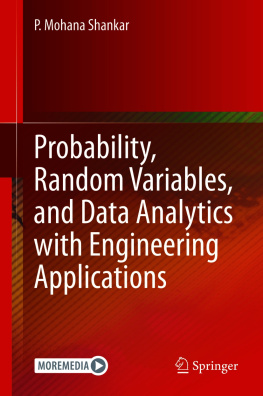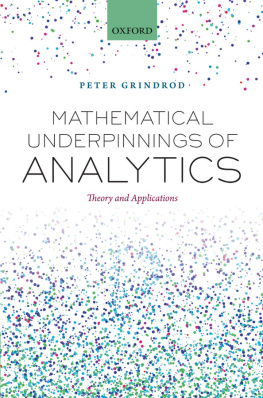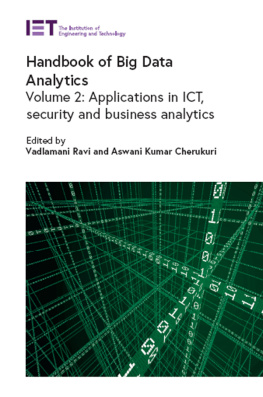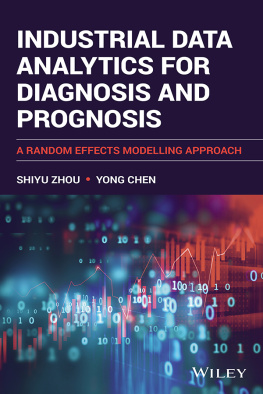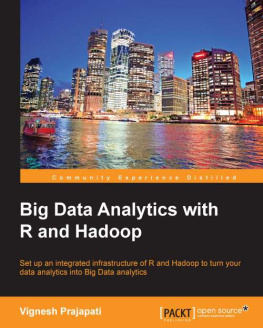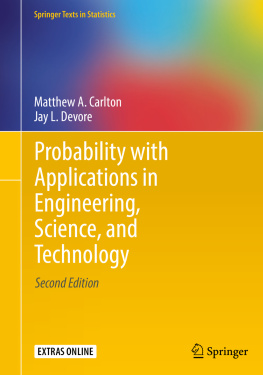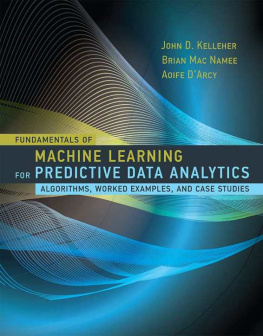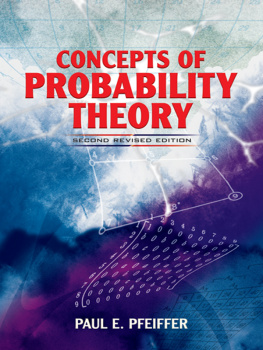P. Mohana Shankar - Probability, Random Variables, and Data Analytics with Engineering Applications
Here you can read online P. Mohana Shankar - Probability, Random Variables, and Data Analytics with Engineering Applications full text of the book (entire story) in english for free. Download pdf and epub, get meaning, cover and reviews about this ebook. year: 2021, publisher: Springer Nature, genre: Home and family. Description of the work, (preface) as well as reviews are available. Best literature library LitArk.com created for fans of good reading and offers a wide selection of genres:
Romance novel
Science fiction
Adventure
Detective
Science
History
Home and family
Prose
Art
Politics
Computer
Non-fiction
Religion
Business
Children
Humor
Choose a favorite category and find really read worthwhile books. Enjoy immersion in the world of imagination, feel the emotions of the characters or learn something new for yourself, make an fascinating discovery.
- Book:Probability, Random Variables, and Data Analytics with Engineering Applications
- Author:
- Publisher:Springer Nature
- Genre:
- Year:2021
- Rating:3 / 5
- Favourites:Add to favourites
- Your mark:
- 60
- 1
- 2
- 3
- 4
- 5
Probability, Random Variables, and Data Analytics with Engineering Applications: summary, description and annotation
We offer to read an annotation, description, summary or preface (depends on what the author of the book "Probability, Random Variables, and Data Analytics with Engineering Applications" wrote himself). If you haven't found the necessary information about the book — write in the comments, we will try to find it.
P. Mohana Shankar: author's other books
Who wrote Probability, Random Variables, and Data Analytics with Engineering Applications? Find out the surname, the name of the author of the book and a list of all author's works by series.
Probability, Random Variables, and Data Analytics with Engineering Applications — read online for free the complete book (whole text) full work
Below is the text of the book, divided by pages. System saving the place of the last page read, allows you to conveniently read the book "Probability, Random Variables, and Data Analytics with Engineering Applications" online for free, without having to search again every time where you left off. Put a bookmark, and you can go to the page where you finished reading at any time.
Font size:
Interval:
Bookmark:
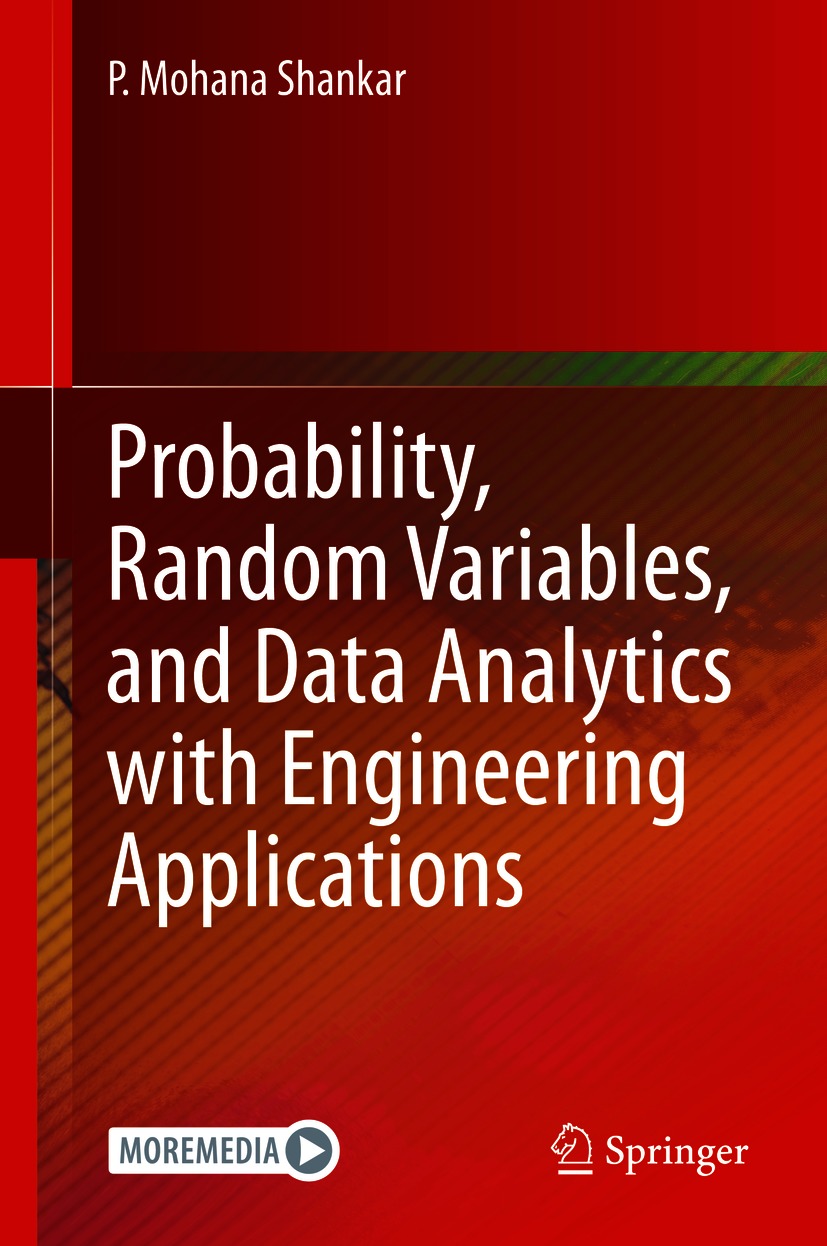

This Springer imprint is published by the registered company Springer Nature Switzerland AG
The registered company address is: Gewerbestrasse 11, 6330 Cham, Switzerland
Dedicated to my parents Padmanabharao and Kanakabai who were teachers.
This book presents the essential elements of probability and statistics and their applications relevant to engineering applications. The topics covered along with examples and demos are expected to meet the requirements of the undergraduate course in probability for students pursuing engineering education. A unique feature of the book has been the inclusion of computational aspects involving examples and exercises requiring random number simulations and data analysis. This paradigm shift in the contents of the book offers an opportunity to link concepts in statistics (including random variables) to practical applications in engineering, business and medicine. With Excel spreadsheets of data provided, the book offers a balanced mix of traditional topics and data analytics, expanding the scope, diversity and applications of engineering probability. The solution manual will be available to instructors. It contains solutions to both types of exercises namely the traditional ones and analytical ones and others based on data sets relevant to machine vision, machine learning and medical diagnostics.
The book took almost 3 years to complete and grew out of the notes, examples, demos and exercises created while teaching engineering probability in the Department of Electrical and Computer Engineering, Drexel University during the past several years. The timely completion of the book was possible only through the wholehearted support and active engagement of my wife Raja and daughter Raji. Their support was immeasurable and invaluable.
I also want to express my sincere thanks to Mary James, Brian Halm and Zoe Kennedy at Spinger (New York) and the Springer production team (Brinda Megasyamalan, Silembarasan Pannerselvam and Mario Gabriele) for their commitment and support to the book project.
The topics in probability and statistics are concept driven, and textbooks devoted to these require a different mode of presentation than the traditional ones seen in mathematics. The key difference is that the examples must be relevant to the students for whom the course in probability is a curricular requirement. While the students might have been exposed to some elements of probability, the idea of experiments with outcomes being described in statistical terms is novel to them. Thus the introduction of randomness and the notion of a random variable are abstract and require example driven methodology in presentation. Since engineering applications of probability include modeling of outcomes and testing the validity of the models, the book must be thematic with particular emphasis on engineering problems that students may encounter either in school or in their professional world after graduation. This book has been prepared keeping this central theme, namely, application-oriented presentation in terms of examples and exercises. Industrial, commercial, and medical applications involve collection, analysis, interpretation of data, etc., and therefore students must also learn computational techniques. This aspect adds another component to the presentation as well as the choice of examples and exercises.
Chapter begins with the elementary aspects of probability by starting with sets and Venn diagrams. The concepts of probability follow with appropriate descriptions of marginal, joint, conditional, and total probabilities, Bayes rule , Bernoulli trials , etc. Examples include those that examine the notion of continuous probability as a prelude to the presentation of random variables in the next chapter. Keeping with the theme of application oriented content, the chapter contains topics in data analytics such as the estimation of priori, conditional and posteriori probabilities associated with a given set of data collected from measurements. The presentation of the subject matter is organized to offer the reader the importance and relevance of the topics to present day engineering problems. The association between transition matrix and confusion matrix is introduced to illustrate the connection of the probability concepts to data science. Examples and exercises include conceptual and data analytics based ones.
The concept of a random variable and its importance in modeling the outcomes of experiments are presented in Chap.. Chapter summary provided offers detailed descriptions of densities and their properties. Multiple examples of transformation of variables are also presented. Examples and exercises include traditional analytical ones alongside data based ones requiring computational approaches.
Chapter , before invoking the approaches requiring the use of Leibniz theorem and Jacobian. Modeling of outcomes in an experiment is presented as a two-stage experiment. Characteristic functions and Laplace transforms are offered for the determination of the densities of the sum and difference of variables. Mellin transforms (a topic not covered in textbooks) are presented as a means to obtain the densities of the products and ratios of two or more random variables. Meijer G functions are introduced to express the densities of products of random variables. The chapter offers detailed descriptions of the central limit theorem (sums and products) and order statistics. The examples and exercises are applications oriented and often involve the use of computational approaches.
Font size:
Interval:
Bookmark:
Similar books «Probability, Random Variables, and Data Analytics with Engineering Applications»
Look at similar books to Probability, Random Variables, and Data Analytics with Engineering Applications. We have selected literature similar in name and meaning in the hope of providing readers with more options to find new, interesting, not yet read works.
Discussion, reviews of the book Probability, Random Variables, and Data Analytics with Engineering Applications and just readers' own opinions. Leave your comments, write what you think about the work, its meaning or the main characters. Specify what exactly you liked and what you didn't like, and why you think so.

